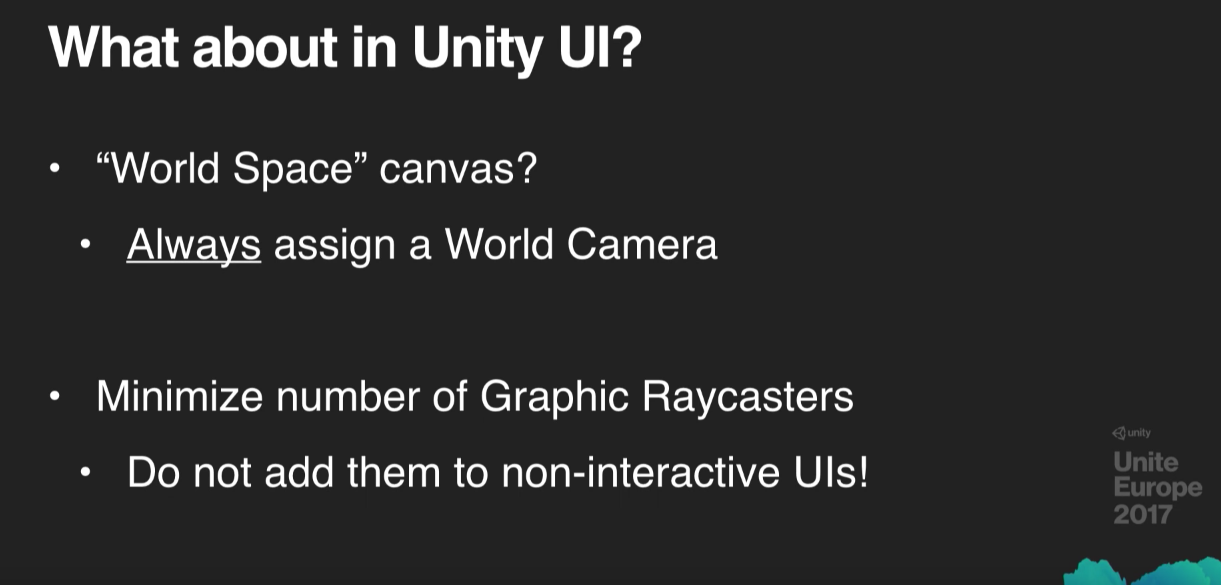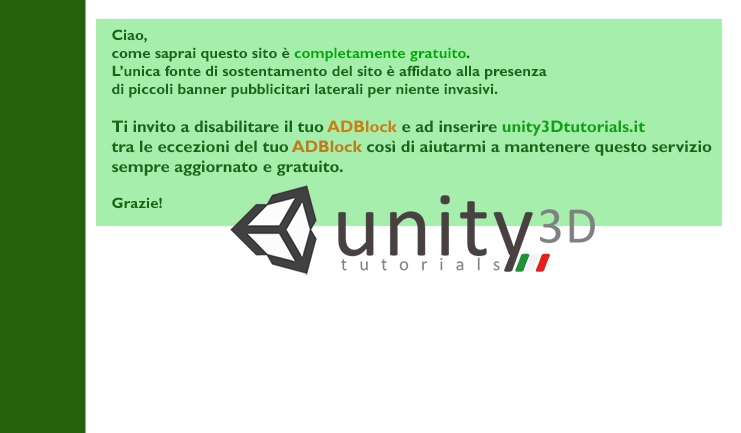Uno dei problemi noti delle UI di Unity sta nella scarsa fluidità degli scrollRect e delle UI in generale, come per esempio durante il drag&Drop degli elementi come icone e immagini. Il lag aumenta in modo esponenziale se utilizzati su dispositivi mobili sopratutto in presenza di tanti elementi all’interno di un pannello “scrollabile”. Dovremmo trovare qualche stratagemma per migliorare l’effetto visivo dello scrolling.
Per ovviare a questo problema ho raccolto tre metodi differenti che, se usati contemporaneamente, potranno aumentare sensibilmente le performance delle vostre UI e rendere l’aspetto del movimento più veloce e fluido.
Vi ricordo che se non conoscete già le UI, questo articolo potrebbe essere troppo avanzato e vi invito ad approfondire l’argomento nell’apposita sessione sulle UI di Unity.
Opzione 1
Abbiamo uno script alternativo allo ScrollRect, che io ho chiamato fantasiosamente ScrollRect2 che possiamo usare al posto del normale ScrollRect.
Con questo script non aumenteranno veramente le performance ma potrete settare la velocità di scorrimento che di norma è molto lento sui dispositivi mobili.
Lo script è fondamentalmente identico all’originale ScrollRect, ma con due modifiche sostanziali.
Una alla riga 70, dove abbiamo aggiunto due righe e l’altro alla riga 356.
Non c’è molto da dire, semplicemente, usate questo al posto del normale ScrollRect e siate felici.
Usando quest’opzione i miglioramenti di velocità di scorrimento si potranno notare sopratutto su dispositivi mobili dove avremo delle viewport molto grandi, piene di elementi o con immagini molto grandi da scorrere.
using System;
using UnityEngine.Events;
using UnityEngine.EventSystems;
namespace UnityEngine.UI
{
[AddComponentMenu("UI/Scroll Rect", 37)]
[SelectionBase]
[ExecuteInEditMode]
[DisallowMultipleComponent]
[RequireComponent(typeof(RectTransform))]
public class ScrollRect2 : UIBehaviour, IInitializePotentialDragHandler, IBeginDragHandler, IEndDragHandler, IDragHandler, IScrollHandler, ICanvasElement, ILayoutElement, ILayoutGroup
{
public enum MovementType
{
Unrestricted, // Unrestricted movement -- can scroll forever
Elastic, // Restricted but flexible -- can go past the edges, but springs back in place
Clamped, // Restricted movement where it's not possible to go past the edges
}
public enum ScrollbarVisibility
{
Permanent,
AutoHide,
AutoHideAndExpandViewport,
}
[Serializable]
public class ScrollRectEvent : UnityEvent<Vector2> { }
[SerializeField]
private RectTransform m_Content;
public RectTransform content { get { return m_Content; } set { m_Content = value; } }
[SerializeField]
private bool m_Horizontal = true;
public bool horizontal { get { return m_Horizontal; } set { m_Horizontal = value; } }
[SerializeField]
private bool m_Vertical = true;
public bool vertical { get { return m_Vertical; } set { m_Vertical = value; } }
[SerializeField]
private MovementType m_MovementType = MovementType.Elastic;
public MovementType movementType { get { return m_MovementType; } set { m_MovementType = value; } }
[SerializeField]
private float m_Elasticity = 0.1f; // Only used for MovementType.Elastic
public float elasticity { get { return m_Elasticity; } set { m_Elasticity = value; } }
[SerializeField]
private bool m_Inertia = true;
public bool inertia { get { return m_Inertia; } set { m_Inertia = value; } }
[SerializeField]
private float m_DecelerationRate = 0.135f; // Only used when inertia is enabled
public float decelerationRate { get { return m_DecelerationRate; } set { m_DecelerationRate = value; } }
[SerializeField]
private float m_ScrollSensitivity = 1.0f;
public float scrollSensitivity { get { return m_ScrollSensitivity; } set { m_ScrollSensitivity = value; } }
[SerializeField]
private RectTransform m_Viewport;
public RectTransform viewport { get { return m_Viewport; } set { m_Viewport = value; SetDirtyCaching(); } }
/// <summary>
/// Aggiunta allo script originale
/// </summary>
[SerializeField]
private float m_ScrollFactor = 1.0f;
public float scrollFactor { get { return m_ScrollFactor; } set { m_ScrollFactor = value; } }
[SerializeField]
private Scrollbar m_HorizontalScrollbar;
public Scrollbar horizontalScrollbar
{
get
{
return m_HorizontalScrollbar;
}
set
{
if (m_HorizontalScrollbar)
m_HorizontalScrollbar.onValueChanged.RemoveListener(SetHorizontalNormalizedPosition);
m_HorizontalScrollbar = value;
if (m_HorizontalScrollbar)
m_HorizontalScrollbar.onValueChanged.AddListener(SetHorizontalNormalizedPosition);
SetDirtyCaching();
}
}
[SerializeField]
private Scrollbar m_VerticalScrollbar;
public Scrollbar verticalScrollbar
{
get
{
return m_VerticalScrollbar;
}
set
{
if (m_VerticalScrollbar)
m_VerticalScrollbar.onValueChanged.RemoveListener(SetVerticalNormalizedPosition);
m_VerticalScrollbar = value;
if (m_VerticalScrollbar)
m_VerticalScrollbar.onValueChanged.AddListener(SetVerticalNormalizedPosition);
SetDirtyCaching();
}
}
[SerializeField]
private ScrollbarVisibility m_HorizontalScrollbarVisibility;
public ScrollbarVisibility horizontalScrollbarVisibility { get { return m_HorizontalScrollbarVisibility; } set { m_HorizontalScrollbarVisibility = value; SetDirtyCaching(); } }
[SerializeField]
private ScrollbarVisibility m_VerticalScrollbarVisibility;
public ScrollbarVisibility verticalScrollbarVisibility { get { return m_VerticalScrollbarVisibility; } set { m_VerticalScrollbarVisibility = value; SetDirtyCaching(); } }
[SerializeField]
private float m_HorizontalScrollbarSpacing;
public float horizontalScrollbarSpacing { get { return m_HorizontalScrollbarSpacing; } set { m_HorizontalScrollbarSpacing = value; SetDirty(); } }
[SerializeField]
private float m_VerticalScrollbarSpacing;
public float verticalScrollbarSpacing { get { return m_VerticalScrollbarSpacing; } set { m_VerticalScrollbarSpacing = value; SetDirty(); } }
[SerializeField]
private ScrollRectEvent m_OnValueChanged = new ScrollRectEvent();
public ScrollRectEvent onValueChanged { get { return m_OnValueChanged; } set { m_OnValueChanged = value; } }
// The offset from handle position to mouse down position
private Vector2 m_PointerStartLocalCursor = Vector2.zero;
private Vector2 m_ContentStartPosition = Vector2.zero;
private RectTransform m_ViewRect;
protected RectTransform viewRect
{
get
{
if (m_ViewRect == null)
m_ViewRect = m_Viewport;
if (m_ViewRect == null)
m_ViewRect = (RectTransform)transform;
return m_ViewRect;
}
}
private Bounds m_ContentBounds;
private Bounds m_ViewBounds;
private Vector2 m_Velocity;
public Vector2 velocity { get { return m_Velocity; } set { m_Velocity = value; } }
private bool m_Dragging;
private Vector2 m_PrevPosition = Vector2.zero;
private Bounds m_PrevContentBounds;
private Bounds m_PrevViewBounds;
[NonSerialized]
private bool m_HasRebuiltLayout = false;
private bool m_HSliderExpand;
private bool m_VSliderExpand;
private float m_HSliderHeight;
private float m_VSliderWidth;
[System.NonSerialized] private RectTransform m_Rect;
private RectTransform rectTransform
{
get
{
if (m_Rect == null)
m_Rect = GetComponent<RectTransform>();
return m_Rect;
}
}
private RectTransform m_HorizontalScrollbarRect;
private RectTransform m_VerticalScrollbarRect;
private DrivenRectTransformTracker m_Tracker;
protected ScrollRect2()
{
flexibleWidth = -1;
}
public virtual void Rebuild(CanvasUpdate executing)
{
if (executing == CanvasUpdate.Prelayout)
{
UpdateCachedData();
}
if (executing == CanvasUpdate.PostLayout)
{
UpdateBounds();
UpdateScrollbars(Vector2.zero);
UpdatePrevData();
m_HasRebuiltLayout = true;
}
}
public virtual void LayoutComplete()
{ }
public virtual void GraphicUpdateComplete()
{ }
void UpdateCachedData()
{
Transform transform = this.transform;
m_HorizontalScrollbarRect = m_HorizontalScrollbar == null ? null : m_HorizontalScrollbar.transform as RectTransform;
m_VerticalScrollbarRect = m_VerticalScrollbar == null ? null : m_VerticalScrollbar.transform as RectTransform;
// These are true if either the elements are children, or they don't exist at all.
bool viewIsChild = (viewRect.parent == transform);
bool hScrollbarIsChild = (!m_HorizontalScrollbarRect || m_HorizontalScrollbarRect.parent == transform);
bool vScrollbarIsChild = (!m_VerticalScrollbarRect || m_VerticalScrollbarRect.parent == transform);
bool allAreChildren = (viewIsChild && hScrollbarIsChild && vScrollbarIsChild);
m_HSliderExpand = allAreChildren && m_HorizontalScrollbarRect && horizontalScrollbarVisibility == ScrollbarVisibility.AutoHideAndExpandViewport;
m_VSliderExpand = allAreChildren && m_VerticalScrollbarRect && verticalScrollbarVisibility == ScrollbarVisibility.AutoHideAndExpandViewport;
m_HSliderHeight = (m_HorizontalScrollbarRect == null ? 0 : m_HorizontalScrollbarRect.rect.height);
m_VSliderWidth = (m_VerticalScrollbarRect == null ? 0 : m_VerticalScrollbarRect.rect.width);
}
protected override void OnEnable()
{
base.OnEnable();
if (m_HorizontalScrollbar)
m_HorizontalScrollbar.onValueChanged.AddListener(SetHorizontalNormalizedPosition);
if (m_VerticalScrollbar)
m_VerticalScrollbar.onValueChanged.AddListener(SetVerticalNormalizedPosition);
CanvasUpdateRegistry.RegisterCanvasElementForLayoutRebuild(this);
}
protected override void OnDisable()
{
CanvasUpdateRegistry.UnRegisterCanvasElementForRebuild(this);
if (m_HorizontalScrollbar)
m_HorizontalScrollbar.onValueChanged.RemoveListener(SetHorizontalNormalizedPosition);
if (m_VerticalScrollbar)
m_VerticalScrollbar.onValueChanged.RemoveListener(SetVerticalNormalizedPosition);
m_HasRebuiltLayout = false;
m_Tracker.Clear();
m_Velocity = Vector2.zero;
LayoutRebuilder.MarkLayoutForRebuild(rectTransform);
base.OnDisable();
}
public override bool IsActive()
{
return base.IsActive() && m_Content != null;
}
private void EnsureLayoutHasRebuilt()
{
if (!m_HasRebuiltLayout && !CanvasUpdateRegistry.IsRebuildingLayout())
Canvas.ForceUpdateCanvases();
}
public virtual void StopMovement()
{
m_Velocity = Vector2.zero;
}
public virtual void OnScroll(PointerEventData data)
{
if (!IsActive())
return;
EnsureLayoutHasRebuilt();
UpdateBounds();
Vector2 delta = data.scrollDelta;
// Down is positive for scroll events, while in UI system up is positive.
delta.y *= -1;
if (vertical && !horizontal)
{
if (Mathf.Abs(delta.x) > Mathf.Abs(delta.y))
delta.y = delta.x;
delta.x = 0;
}
if (horizontal && !vertical)
{
if (Mathf.Abs(delta.y) > Mathf.Abs(delta.x))
delta.x = delta.y;
delta.y = 0;
}
Vector2 position = m_Content.anchoredPosition;
position += delta * m_ScrollSensitivity;
if (m_MovementType == MovementType.Clamped)
position += CalculateOffset(position - m_Content.anchoredPosition);
SetContentAnchoredPosition(position);
UpdateBounds();
}
public virtual void OnInitializePotentialDrag(PointerEventData eventData)
{
if (eventData.button != PointerEventData.InputButton.Left)
return;
m_Velocity = Vector2.zero;
}
public virtual void OnBeginDrag(PointerEventData eventData)
{
if (eventData.button != PointerEventData.InputButton.Left)
return;
if (!IsActive())
return;
UpdateBounds();
m_PointerStartLocalCursor = Vector2.zero;
RectTransformUtility.ScreenPointToLocalPointInRectangle(viewRect, eventData.position, eventData.pressEventCamera, out m_PointerStartLocalCursor);
m_ContentStartPosition = m_Content.anchoredPosition;
m_Dragging = true;
}
public virtual void OnEndDrag(PointerEventData eventData)
{
if (eventData.button != PointerEventData.InputButton.Left)
return;
m_Dragging = false;
}
public virtual void OnDrag(PointerEventData eventData)
{
if (eventData.button != PointerEventData.InputButton.Left)
return;
if (!IsActive())
return;
Vector2 localCursor;
if (!RectTransformUtility.ScreenPointToLocalPointInRectangle(viewRect, eventData.position, eventData.pressEventCamera, out localCursor))
return;
UpdateBounds();
var pointerDelta = localCursor - m_PointerStartLocalCursor;
pointerDelta *= m_ScrollFactor; // Questa linea è nuova!
Vector2 position = m_ContentStartPosition + pointerDelta;
// Offset to get content into place in the view.
Vector2 offset = CalculateOffset(position - m_Content.anchoredPosition);
position += offset;
if (m_MovementType == MovementType.Elastic)
{
if (offset.x != 0)
position.x = position.x - RubberDelta(offset.x, m_ViewBounds.size.x);
if (offset.y != 0)
position.y = position.y - RubberDelta(offset.y, m_ViewBounds.size.y);
}
SetContentAnchoredPosition(position);
}
protected virtual void SetContentAnchoredPosition(Vector2 position)
{
if (!m_Horizontal)
position.x = m_Content.anchoredPosition.x;
if (!m_Vertical)
position.y = m_Content.anchoredPosition.y;
if (position != m_Content.anchoredPosition)
{
m_Content.anchoredPosition = position;
UpdateBounds();
}
}
protected virtual void LateUpdate()
{
if (!m_Content)
return;
EnsureLayoutHasRebuilt();
UpdateScrollbarVisibility();
UpdateBounds();
float deltaTime = Time.unscaledDeltaTime;
Vector2 offset = CalculateOffset(Vector2.zero);
if (!m_Dragging && (offset != Vector2.zero || m_Velocity != Vector2.zero))
{
Vector2 position = m_Content.anchoredPosition;
for (int axis = 0; axis < 2; axis++)
{
// Apply spring physics if movement is elastic and content has an offset from the view.
if (m_MovementType == MovementType.Elastic && offset[axis] != 0)
{
float speed = m_Velocity[axis];
position[axis] = Mathf.SmoothDamp(m_Content.anchoredPosition[axis], m_Content.anchoredPosition[axis] + offset[axis], ref speed, m_Elasticity, Mathf.Infinity, deltaTime);
m_Velocity[axis] = speed;
}
// Else move content according to velocity with deceleration applied.
else if (m_Inertia)
{
m_Velocity[axis] *= Mathf.Pow(m_DecelerationRate, deltaTime);
if (Mathf.Abs(m_Velocity[axis]) < 1)
m_Velocity[axis] = 0;
position[axis] += m_Velocity[axis] * deltaTime;
}
// If we have neither elaticity or friction, there shouldn't be any velocity.
else
{
m_Velocity[axis] = 0;
}
}
if (m_Velocity != Vector2.zero)
{
if (m_MovementType == MovementType.Clamped)
{
offset = CalculateOffset(position - m_Content.anchoredPosition);
position += offset;
}
SetContentAnchoredPosition(position);
}
}
if (m_Dragging && m_Inertia)
{
Vector3 newVelocity = (m_Content.anchoredPosition - m_PrevPosition) / deltaTime;
m_Velocity = Vector3.Lerp(m_Velocity, newVelocity, deltaTime * 10);
}
if (m_ViewBounds != m_PrevViewBounds || m_ContentBounds != m_PrevContentBounds || m_Content.anchoredPosition != m_PrevPosition)
{
UpdateScrollbars(offset);
m_OnValueChanged.Invoke(normalizedPosition);
UpdatePrevData();
}
}
private void UpdatePrevData()
{
if (m_Content == null)
m_PrevPosition = Vector2.zero;
else
m_PrevPosition = m_Content.anchoredPosition;
m_PrevViewBounds = m_ViewBounds;
m_PrevContentBounds = m_ContentBounds;
}
private void UpdateScrollbars(Vector2 offset)
{
if (m_HorizontalScrollbar)
{
if (m_ContentBounds.size.x > 0)
m_HorizontalScrollbar.size = Mathf.Clamp01((m_ViewBounds.size.x - Mathf.Abs(offset.x)) / m_ContentBounds.size.x);
else
m_HorizontalScrollbar.size = 1;
m_HorizontalScrollbar.value = horizontalNormalizedPosition;
}
if (m_VerticalScrollbar)
{
if (m_ContentBounds.size.y > 0)
m_VerticalScrollbar.size = Mathf.Clamp01((m_ViewBounds.size.y - Mathf.Abs(offset.y)) / m_ContentBounds.size.y);
else
m_VerticalScrollbar.size = 1;
m_VerticalScrollbar.value = verticalNormalizedPosition;
}
}
public Vector2 normalizedPosition
{
get
{
return new Vector2(horizontalNormalizedPosition, verticalNormalizedPosition);
}
set
{
SetNormalizedPosition(value.x, 0);
SetNormalizedPosition(value.y, 1);
}
}
public float horizontalNormalizedPosition
{
get
{
UpdateBounds();
if (m_ContentBounds.size.x <= m_ViewBounds.size.x)
return (m_ViewBounds.min.x > m_ContentBounds.min.x) ? 1 : 0;
return (m_ViewBounds.min.x - m_ContentBounds.min.x) / (m_ContentBounds.size.x - m_ViewBounds.size.x);
}
set
{
SetNormalizedPosition(value, 0);
}
}
public float verticalNormalizedPosition
{
get
{
UpdateBounds();
if (m_ContentBounds.size.y <= m_ViewBounds.size.y)
return (m_ViewBounds.min.y > m_ContentBounds.min.y) ? 1 : 0;
;
return (m_ViewBounds.min.y - m_ContentBounds.min.y) / (m_ContentBounds.size.y - m_ViewBounds.size.y);
}
set
{
SetNormalizedPosition(value, 1);
}
}
private void SetHorizontalNormalizedPosition(float value) { SetNormalizedPosition(value, 0); }
private void SetVerticalNormalizedPosition(float value) { SetNormalizedPosition(value, 1); }
private void SetNormalizedPosition(float value, int axis)
{
EnsureLayoutHasRebuilt();
UpdateBounds();
// How much the content is larger than the view.
float hiddenLength = m_ContentBounds.size[axis] - m_ViewBounds.size[axis];
// Where the position of the lower left corner of the content bounds should be, in the space of the view.
float contentBoundsMinPosition = m_ViewBounds.min[axis] - value * hiddenLength;
// The new content localPosition, in the space of the view.
float newLocalPosition = m_Content.localPosition[axis] + contentBoundsMinPosition - m_ContentBounds.min[axis];
Vector3 localPosition = m_Content.localPosition;
if (Mathf.Abs(localPosition[axis] - newLocalPosition) > 0.01f)
{
localPosition[axis] = newLocalPosition;
m_Content.localPosition = localPosition;
m_Velocity[axis] = 0;
UpdateBounds();
}
}
private static float RubberDelta(float overStretching, float viewSize)
{
return (1 - (1 / ((Mathf.Abs(overStretching) * 0.55f / viewSize) + 1))) * viewSize * Mathf.Sign(overStretching);
}
protected override void OnRectTransformDimensionsChange()
{
SetDirty();
}
private bool hScrollingNeeded
{
get
{
if (Application.isPlaying)
return m_ContentBounds.size.x > m_ViewBounds.size.x + 0.01f;
return true;
}
}
private bool vScrollingNeeded
{
get
{
if (Application.isPlaying)
return m_ContentBounds.size.y > m_ViewBounds.size.y + 0.01f;
return true;
}
}
public virtual void CalculateLayoutInputHorizontal() { }
public virtual void CalculateLayoutInputVertical() { }
public virtual float minWidth { get { return -1; } }
public virtual float preferredWidth { get { return -1; } }
public virtual float flexibleWidth { get; private set; }
public virtual float minHeight { get { return -1; } }
public virtual float preferredHeight { get { return -1; } }
public virtual float flexibleHeight { get { return -1; } }
public virtual int layoutPriority { get { return -1; } }
public virtual void SetLayoutHorizontal()
{
m_Tracker.Clear();
if (m_HSliderExpand || m_VSliderExpand)
{
m_Tracker.Add(this, viewRect,
DrivenTransformProperties.Anchors |
DrivenTransformProperties.SizeDelta |
DrivenTransformProperties.AnchoredPosition);
// Make view full size to see if content fits.
viewRect.anchorMin = Vector2.zero;
viewRect.anchorMax = Vector2.one;
viewRect.sizeDelta = Vector2.zero;
viewRect.anchoredPosition = Vector2.zero;
// Recalculate content layout with this size to see if it fits when there are no scrollbars.
LayoutRebuilder.ForceRebuildLayoutImmediate(content);
m_ViewBounds = new Bounds(viewRect.rect.center, viewRect.rect.size);
m_ContentBounds = GetBounds();
}
// If it doesn't fit vertically, enable vertical scrollbar and shrink view horizontally to make room for it.
if (m_VSliderExpand && vScrollingNeeded)
{
viewRect.sizeDelta = new Vector2(-(m_VSliderWidth + m_VerticalScrollbarSpacing), viewRect.sizeDelta.y);
// Recalculate content layout with this size to see if it fits vertically
// when there is a vertical scrollbar (which may reflowed the content to make it taller).
LayoutRebuilder.ForceRebuildLayoutImmediate(content);
m_ViewBounds = new Bounds(viewRect.rect.center, viewRect.rect.size);
m_ContentBounds = GetBounds();
}
// If it doesn't fit horizontally, enable horizontal scrollbar and shrink view vertically to make room for it.
if (m_HSliderExpand && hScrollingNeeded)
{
viewRect.sizeDelta = new Vector2(viewRect.sizeDelta.x, -(m_HSliderHeight + m_HorizontalScrollbarSpacing));
m_ViewBounds = new Bounds(viewRect.rect.center, viewRect.rect.size);
m_ContentBounds = GetBounds();
}
// If the vertical slider didn't kick in the first time, and the horizontal one did,
// we need to check again if the vertical slider now needs to kick in.
// If it doesn't fit vertically, enable vertical scrollbar and shrink view horizontally to make room for it.
if (m_VSliderExpand && vScrollingNeeded && viewRect.sizeDelta.x == 0 && viewRect.sizeDelta.y < 0)
{
viewRect.sizeDelta = new Vector2(-(m_VSliderWidth + m_VerticalScrollbarSpacing), viewRect.sizeDelta.y);
}
}
public virtual void SetLayoutVertical()
{
UpdateScrollbarLayout();
m_ViewBounds = new Bounds(viewRect.rect.center, viewRect.rect.size);
m_ContentBounds = GetBounds();
}
void UpdateScrollbarVisibility()
{
if (m_VerticalScrollbar && m_VerticalScrollbarVisibility != ScrollbarVisibility.Permanent && m_VerticalScrollbar.gameObject.activeSelf != vScrollingNeeded)
m_VerticalScrollbar.gameObject.SetActive(vScrollingNeeded);
if (m_HorizontalScrollbar && m_HorizontalScrollbarVisibility != ScrollbarVisibility.Permanent && m_HorizontalScrollbar.gameObject.activeSelf != hScrollingNeeded)
m_HorizontalScrollbar.gameObject.SetActive(hScrollingNeeded);
}
void UpdateScrollbarLayout()
{
if (m_VSliderExpand && m_HorizontalScrollbar)
{
m_Tracker.Add(this, m_HorizontalScrollbarRect,
DrivenTransformProperties.AnchorMinX |
DrivenTransformProperties.AnchorMaxX |
DrivenTransformProperties.SizeDeltaX |
DrivenTransformProperties.AnchoredPositionX);
m_HorizontalScrollbarRect.anchorMin = new Vector2(0, m_HorizontalScrollbarRect.anchorMin.y);
m_HorizontalScrollbarRect.anchorMax = new Vector2(1, m_HorizontalScrollbarRect.anchorMax.y);
m_HorizontalScrollbarRect.anchoredPosition = new Vector2(0, m_HorizontalScrollbarRect.anchoredPosition.y);
if (vScrollingNeeded)
m_HorizontalScrollbarRect.sizeDelta = new Vector2(-(m_VSliderWidth + m_VerticalScrollbarSpacing), m_HorizontalScrollbarRect.sizeDelta.y);
else
m_HorizontalScrollbarRect.sizeDelta = new Vector2(0, m_HorizontalScrollbarRect.sizeDelta.y);
}
if (m_HSliderExpand && m_VerticalScrollbar)
{
m_Tracker.Add(this, m_VerticalScrollbarRect,
DrivenTransformProperties.AnchorMinY |
DrivenTransformProperties.AnchorMaxY |
DrivenTransformProperties.SizeDeltaY |
DrivenTransformProperties.AnchoredPositionY);
m_VerticalScrollbarRect.anchorMin = new Vector2(m_VerticalScrollbarRect.anchorMin.x, 0);
m_VerticalScrollbarRect.anchorMax = new Vector2(m_VerticalScrollbarRect.anchorMax.x, 1);
m_VerticalScrollbarRect.anchoredPosition = new Vector2(m_VerticalScrollbarRect.anchoredPosition.x, 0);
if (hScrollingNeeded)
m_VerticalScrollbarRect.sizeDelta = new Vector2(m_VerticalScrollbarRect.sizeDelta.x, -(m_HSliderHeight + m_HorizontalScrollbarSpacing));
else
m_VerticalScrollbarRect.sizeDelta = new Vector2(m_VerticalScrollbarRect.sizeDelta.x, 0);
}
}
private void UpdateBounds()
{
m_ViewBounds = new Bounds(viewRect.rect.center, viewRect.rect.size);
m_ContentBounds = GetBounds();
if (m_Content == null)
return;
// Make sure content bounds are at least as large as view by adding padding if not.
// One might think at first that if the content is smaller than the view, scrolling should be allowed.
// However, that's not how scroll views normally work.
// Scrolling is *only* possible when content is *larger* than view.
// We use the pivot of the content rect to decide in which directions the content bounds should be expanded.
// E.g. if pivot is at top, bounds are expanded downwards.
// This also works nicely when ContentSizeFitter is used on the content.
Vector3 contentSize = m_ContentBounds.size;
Vector3 contentPos = m_ContentBounds.center;
Vector3 excess = m_ViewBounds.size - contentSize;
if (excess.x > 0)
{
contentPos.x -= excess.x * (m_Content.pivot.x - 0.5f);
contentSize.x = m_ViewBounds.size.x;
}
if (excess.y > 0)
{
contentPos.y -= excess.y * (m_Content.pivot.y - 0.5f);
contentSize.y = m_ViewBounds.size.y;
}
m_ContentBounds.size = contentSize;
m_ContentBounds.center = contentPos;
}
private readonly Vector3[] m_Corners = new Vector3[4];
private Bounds GetBounds()
{
if (m_Content == null)
return new Bounds();
var vMin = new Vector3(float.MaxValue, float.MaxValue, float.MaxValue);
var vMax = new Vector3(float.MinValue, float.MinValue, float.MinValue);
var toLocal = viewRect.worldToLocalMatrix;
m_Content.GetWorldCorners(m_Corners);
for (int j = 0; j < 4; j++)
{
Vector3 v = toLocal.MultiplyPoint3x4(m_Corners[j]);
vMin = Vector3.Min(v, vMin);
vMax = Vector3.Max(v, vMax);
}
var bounds = new Bounds(vMin, Vector3.zero);
bounds.Encapsulate(vMax);
return bounds;
}
private Vector2 CalculateOffset(Vector2 delta)
{
Vector2 offset = Vector2.zero;
if (m_MovementType == MovementType.Unrestricted)
return offset;
Vector2 min = m_ContentBounds.min;
Vector2 max = m_ContentBounds.max;
if (m_Horizontal)
{
min.x += delta.x;
max.x += delta.x;
if (min.x > m_ViewBounds.min.x)
offset.x = m_ViewBounds.min.x - min.x;
else if (max.x < m_ViewBounds.max.x)
offset.x = m_ViewBounds.max.x - max.x;
}
if (m_Vertical)
{
min.y += delta.y;
max.y += delta.y;
if (max.y < m_ViewBounds.max.y)
offset.y = m_ViewBounds.max.y - max.y;
else if (min.y > m_ViewBounds.min.y)
offset.y = m_ViewBounds.min.y - min.y;
}
return offset;
}
protected void SetDirty()
{
if (!IsActive())
return;
LayoutRebuilder.MarkLayoutForRebuild(rectTransform);
}
protected void SetDirtyCaching()
{
if (!IsActive())
return;
CanvasUpdateRegistry.RegisterCanvasElementForLayoutRebuild(this);
LayoutRebuilder.MarkLayoutForRebuild(rectTransform);
}
#if UNITY_EDITOR
protected override void OnValidate()
{
SetDirtyCaching();
}
#endif
}
}<span id="mce_marker" data-mce-type="bookmark" data-mce-fragment="1"></span>
|
Vi ricordo che per copiare il codice potete selezionarlo tramite l’icona in alto a destra della finestra dello script. |
Create dunque un nuovo script chiamato ScrollRect2.cs e incollateci questo codice.
Sul gameObject dove avete lo ScrollRect ,toglietelo e sostituitelo con questo.
Opzione 2
Un altro metodo per migliorare le performance delle UI sta nel deselezionare la spunta PixelPerfect sul canvas.

PixelPerfect forza tutti gli elementi nel canvas ad allinearsi con i pixel. Si applica solo con renderMode su Screen Space.
L’attivazione di pixelPerfect può rendere gli elementi più nitidi e prevenire la sfocatura. Tuttavia, se molti elementi sono ridimensionati, ruotati o animati, quest’opzione rallenta pesantemente l’aggiornamento della canvas. Potrebbe essere vantaggioso disabilitare pixelPerfect e testare il guadagno in performance.
Opzione 3
Un altro “stratagemma” per migliorare le prestazioni delle UI sta nel cambiare il materiale agli elementi dell’UI.
Invece di lasciarlo “vuoto”, scegliete lo Sprites-Default. Se non riscontrerete problemi di visualizzazione con le maschere, questo farà aumentare il refresh dell’elemento UI.
Nota a margine
Ne caso in cui la vostra UI usi il Render Mode di tipo “World Space” ricordatevi sempre di impostare la Event Camera anche se non avete bisogno di registrare eventi altrimenti il sistema andrà alla ricerca continua delle telecamera con un sensibile e inutile calo di prestazioni.

Conclusioni Finali
Utilizzando tutte e tre questi sistemi, le vostre UI saranno (o sembreranno) più leggere da “muovere” sia per lo scrolling che per il drag&Drop e potranno risultare più piacevoli e meno pesanti alla vista dell’utente.





Un pensiero su “UI – Migliorare la fluidità di uno ScrollRect”
If you are going for finest contents like I do, just go to see this web site all the time as it offers quality contents,
thanks